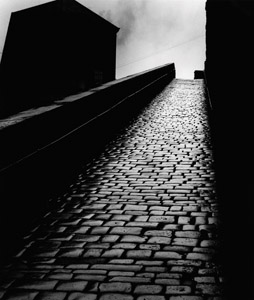
A Snicket, Halifax 1937© Bill Brandt Archive
This book covers 11 photographs from 1835 to 2005, from William Henry Fox Talbot to Jeff Wall.
The premise of the book is that most modern photography has become series oriented, that photography and photographers now work in sets of images rather than in singular works. This is in contrast to painting where each work is seen as distinct and unique. The book intends to have writers comment on a singular image rather than a body of work.
Thirty years ago, in an age where the status of photography as an art was still being debated, Beaumont Newhall won a bet by speaking for an hour on Stieglitz's "The Stearage", Today I doubt anyone would argue that photography is not an art form, especially with a Steichen print recently reaching 2.9 million dollars at auction. But how does one go about the criticism of photography?
The same way as for painting or any other visual art apparently. First, put the artist into context for the reader, place the individual work into the overall body of work for that artist, and then discuss the work itself. Any artist's work can be said to be part of a series, after all artists produce a chronological body of images regardless of whether or not they're supposed to be related. Some artists work in "sets" of images, some do not. That many modern photographers create multiple works based around a single theme is no more or less noteworthy than a painter who does the same. The essayists in this book are in fact, largely silent on this point. There are several photographs in the book which are pulled from work that is absolutely intended as serial and the commentators make their points accordingly, without much further fuss.
The reader is left to make their own conclusions and inferences on the singular vs serial question, and I would make no further comment myself except that the title and introduction seems to demand some resolution, and it is an interesting question. The nature of photography, since the negative was invented, is the multiple print, and the mechanical - technical nature of photography encourages the serial image, so I suppose it is inevitable that large numbers of photographers would take a single idea and "beat it to death", or create work that is absolutely dependent on the idea of the series. An example of just such a project is represented in this book by Sugimoto's "Aegean Sea, Pilion". The photo makes little sense as a single image, being a rather ambiguous shot of a calm, foggy sea and skyscape. There is nothing but the empty water blending into the empty sky. As a single image hung on a wall somewhere it might be most kindly described as decorative, but when taken as part of a series, in context with the rest of the artist's work, it becomes more meaningful.
So, for an image like this, it is indeed possible to talk about it specifically, but not in isolation from the rest of the series. One could own this photograph and hang it alone on one's wall, but the image would be much better shown with several others in the series to provide context and meaning.
I suppose then, my comment on the book's premise would be that, for images which are intended as singular, one can discuss them as such, but for images that are intended to be part of a series, one must comment on them in that context. Seems rather an obvious thing to say now that I've written it.